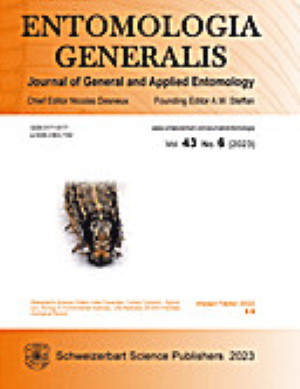Flavonoids mediate systemic defenses induced by root feeding in cotton
IF 4.6
1区 农林科学
Q1 ENTOMOLOGY
引用次数: 0
Abstract
Plant-herbivore interactions dominate food web links in terrestrial settings, thereby shaping ecosystem structure and functioning. Within a given plant, both primary and secondary metabolites mediate the interplay between above- and below-ground herbivores. Here, we investigate how root feeding by larvae of the turnip moth Agrotis segetum (Lepidoptera: Noctuidae) affects development and feeding behavior of an above-ground sap-feeder i.e., the large cotton aphid Acyrthosiphon gossypii (Hemiptera: Aphididae) on cotton. We further draw upon transcriptomics, metabolomics and in-vitro bioassays to elucidate how plant metabolites mediate these interactions. Root feeding reduces A. gossypii adult survival and fecundity by 35.1%. Aphids on A. segetum-infested cotton spend 7% longer probing cells than on un-infested plants. Root and stem herbivory by A. segetum larvae alters gene transcripts and metabolites in leaves, inducing biosynthesis of three flavonoids i.e., dihydromyricetin, phloridzin and dihydroquercetin. In-vitro bioassays show that the latter two compounds markedly decrease A. gossypii adult survival and fecundity. Below-ground herbivory thus elicits biosynthesis and systemic translocation of phloridzin and dihydroquercetin, with antagonistic effects on above-ground sap-feeders. Our study sheds light on the underlying mechanisms of herbivore-triggered plant defenses in cotton and reveals the interplay between herbivore guilds across ecological realms. We discuss the implications of these findings for pest management.类黄酮介导棉花根食诱导的系统防御能力
植物与食草动物之间的相互作用主导着陆地环境中的食物网环节,从而影响着生态系统的结构和功能。在特定植物中,初级和次级代谢物都是地上和地下食草动物相互作用的媒介。在这里,我们研究了萝卜蛾(鳞翅目:夜蛾科)幼虫的根部取食如何影响棉花上的地上取食者,即大型棉蚜 Acyrthosiphon gossypii(半翅目:蚜科)的发育和取食行为。我们进一步利用转录组学、代谢组学和体外生物测定来阐明植物代谢物如何介导这些相互作用。根部取食可使棉蚜成虫存活率和繁殖率降低 35.1%。与未受侵染的植物相比,受 A. segetum 侵染的棉花上的蚜虫探查细胞的时间延长了 7%。蚜虫幼虫对根和茎的食草行为改变了叶片中的基因转录本和代谢物,诱导了三种黄酮类化合物的生物合成,即二氢杨梅素、叶绿素和二氢槲皮素。体外生物测定表明,后两种化合物能显著降低棉铃虫成虫的存活率和繁殖力。因此,地表下的食草动物会引起 phloridzin 和二氢槲皮素的生物合成和系统转移,从而对地表上的食液动物产生拮抗作用。我们的研究揭示了棉花中食草动物触发植物防御的基本机制,并揭示了不同生态区域食草动物之间的相互作用。我们将讨论这些发现对害虫管理的影响。
本文章由计算机程序翻译,如有差异,请以英文原文为准。
求助全文
约1分钟内获得全文
求助全文
来源期刊

Entomologia Generalis
生物-昆虫学
CiteScore
7.10
自引率
18.80%
发文量
72
审稿时长
>12 weeks
期刊介绍:
Its scope covers all aspects of basic and applied research dealing with insects and more broadly with arthropods inhabiting wild, agricultural and/or urban habitats. The journal also considers research integrating various disciplines and issues within the broad field of entomology and ecology.
Entomologia Generalis publishes high quality research articles on advances in knowledge on the ecology and biology of arthropods, as well as on their importance for key ecosystems services, e.g. as biological control and pollination. The journal devotes special attention to contributions providing significant advances (i) on the fundamental knowledge and on sustainable control strategies of arthropod pests (including of stored products) and vectors of diseases, (ii) on the biology and ecology of beneficial arthropods, (iii) on the spread and impact of invasive pests, and (iv) on potential side effects of pest management methods.
Entomologia Generalis welcomes review articles on significant developments in the field of entomology. These are usually invited by the editorial board, but proposals may be sent to the Editor-in-Chief for preliminary assessment by the editorial board before formal submission to the journal. The journal also considers comments on papers published in Entomologia Generalis, as well as short notes on topics that are of broader interest.
 求助内容:
求助内容: 应助结果提醒方式:
应助结果提醒方式:


